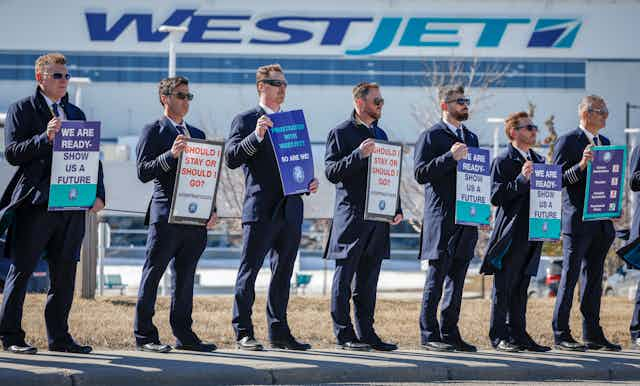WestJet pilots are poised to start striking on Friday after issuing a 72-hour strike notice, leaving some Canadians’ long weekend travel plans up in the air.
Contract negotiations between the Air Line Pilots Association and airline management fell through over pay, work conditions and job protections. According to the CEO of WestJet, there is still a massive gap between the expectations of pilots and that of the airline.
One of the key issues that has led to the current dispute is pilot retention. A high number of pilots have been leaving WestJet, resulting in scheduling uncertainty for those who remain.
Additionally, pilots are concerned about the two-tier system of pay between pilots at WestJet and its subsidiary, Swoop. The pilots’ union has also pointed to the significant difference in levels of pay at WestJet — the second largest airline in Canada — and counterparts in the United States.
While contract negotiations are still ongoing, flying customers are undoubtedly watching the situation unfold nervously. If the strike action goes ahead, it will result in problems for all involved — customers, pilots and the airline.
Customers will face flight cancellations, pilots will lose out on pay, and the airline itself will suffer revenue losses from the cancelled flights. The airline might also experience decreased customer confidence regarding future bookings.
The legacy of deregulation
While COVID-19 undoubtedly impacted the aviation industry, problems were already present prior to the pandemic. The crisis simply intensified these issues.
The deregulation of commercial aviation provided airlines with the motive, means and opportunity to reduce costs.
Deregulation meant that airlines were able to set the fare for their flights, thereby generating a powerful incentive to compete on fare and to reduce costs in order to do so. Deregulation also saw the emergence of new low-cost carriers that directly competed with established airlines and whose success intensified cost reduction at established airlines.

It is difficult for an airline to reduce many operational costs, such as fuel. One cost that isn’t fixed is the cost of labour. It should come as no surprise that cost-cutting in response to deregulation led to a reduction in labour costs and reduced terms and conditions of employment.
While reduced terms and conditions of employment is bad for all employees affected, operating with inferior terms and conditions for highly trained employees like pilots is a high-risk strategy for any airline.
Pilots can, and do, leave one airline for another if the terms and conditions are better, as the case of WestJet in recent years demonstrates.
Labour supply problems
Cutting labour costs has created a labour supply problem. Becoming an airline pilot is far less attractive than it once was.
The time commitment required to become a commercial aviator is significant and the total financial commitment is estimated to be around $100,000.
That is a daunting sum, especially when one’s starting salary can be $65,000 and a pilot can lose their license at any point because commercial aviation has high reliability standards; pilot mental and physical health must be paramount.
The labour supply problem has recently been used in support of a proposal for single pilot operations. Single pilot operations would mean a single pilot rather than two in the flight deck assisted by a remote pilot if necessary.

Deregulation has ultimately reduced the supply of pilots, creating a tighter labour market. This, in turn, has been used to justify reducing the requirement for pilots.
As a resolution to the insufficient supply of pilots, this policy is fraught with numerous problems. These problems include safety and security concerns, a negative impact on other employee groups in aviation — like cabin crew and air traffic control officers — and the perpetuation of a field dominated by white men. If the requirement for pilots drops, so does the probability of greater diversity.
It’s unlikely that commercial airlines will be able to introduce single pilot operations any time soon. The proposal is still under discussion by aviation authorities.
In the meantime, what should airlines do to attract and retain pilots?
Investing in employees
One approach is to invest in employees as illustrated by the pay deal struck by pilots at Delta Air Lines. Pilots approved a new contract to increase pay by 34 per cent pay by 2026.
This deal is not just good for improving labour conditions — it is good business sense. Raising wages in this way enhances what is known as external equity, or the perceived fairness of wages compared to other employers. It increases employee commitment to their employer, and thereby improves staff retention.
Airlines — WestJet included — are service providers dependent upon the efforts of employees. As Herb Kelleher, founder and former CEO of one of the most successful and incidentally most highly unionized airlines in the U.S., Southwest Airlines, once said: “Your people come first, and if you treat them right, they’ll treat the customers right.”
Investment in employees is the key to airline success. WestJet might discover this the hard way.

